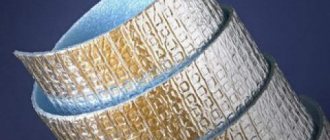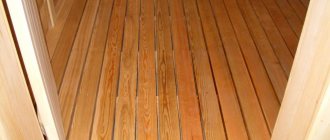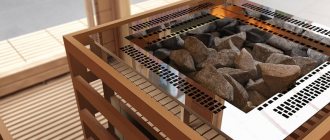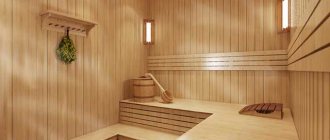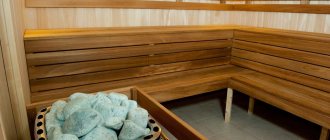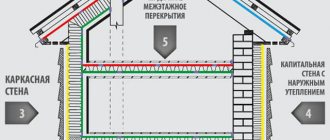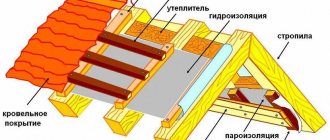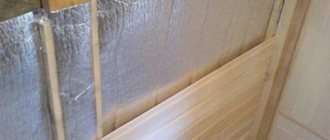To create a fully functional vapor barrier in rooms with unstable temperature and humidity levels, it is necessary to use appropriate materials tailored to specific specifications. Similar conditions are formed in buildings such as bathhouses, attics, unheated cottages and extensions. Considering the features, a good solution would be to install a fabric such as a foil vapor barrier. But in order to ultimately obtain a fully functioning protective layer, many factors should be taken into account.
Principle of operation
Foil materials are a complex product with a layered structure. The base here is polypropylene fabric, fiberglass, and lavsan. These are components that are resistant to explosive effects, biological and chemical aggression.
The use of a durable non-woven or woven polymer base allows you to create a reliable base for metal foil, which itself cannot boast of particular strength. At the same time, flexibility convenient for installation is maintained. This composition eliminates the possibility of fungal colonies settling and rotting.
Vapor barrier materials on the working side are backed with metallized film. The positive qualities of both aluminum foil and the polymer base are preserved. Vapor barrier with foil copes with three tasks at once:
- Insulation from precipitation and steam. The foil material protects the wall insulation system or roofing pie from steam penetration.
- Reflection of thermal radiation. The metal coating serves as a kind of reflector; it interrupts the flow of heat waves, redirecting the stopped heat within the house.
- Protection from ultraviolet rays and wind. Vapor barrier films are a durable barrier against wind. In the summer, they are able to reflect the sun's rays from the roof if they are installed with the working side facing outwards.
Dew point problem
Ideally, the roof in the attic should be insulated from the outside at the stage of forming the roofing pie. However, often this is done the other way around from the inside, when the house is already covered with a roof. And here certain problems arise.
The correct and ideal roofing pie is several layers of different materials laid on top of the rafters tightly on top of each other without gaps. Such a sandwich ensures that the dew point will be located on its outer side. As a result, all condensate formed outside will quickly evaporate into the atmosphere.
By doing insulation from the inside, after installing the roof, it is impossible to form the exemplary roofing pie described above. It will not be possible to press the insulation onto the roof so that there are no voids left between them.
But steam always moves towards cold air. And then, each of the formed cavities will begin to accumulate condensation and moisture. And this is a direct path to damage to the thermal insulation material and wooden elements of the rafter system.
When insulating an attic internally, the dew point has to be shifted into the space between the laid roof and the insulation, leaving an additional 5–10 cm gap there for ventilation. Only such a technology and such a cake will avoid moisture in the insulating material.
To reduce the amount of water vapor in the insulation, its installation should be done using a vapor barrier film. A vapor barrier is installed from the inside of the attic on top of the thermal insulation material.
The steam must first encounter this film and mostly remain in the room. The less of it gets into the insulation layer, the better.
Methods of application
The structure of foil vapor barrier materials has significantly expanded the scope of application. Now they are actively used in insulated roofs , they are often placed on the inside of the roof pie, and in the south they are usually mounted above the insulation. If the house has an unfurnished attic, then foil protection is installed along with waterproofing.
They are often used as a substrate for floor coverings and underfloor heating systems, and for insulating frame wall structures. A foil vapor barrier is also installed in the form of a screen that reflects heat flows from any heating units.
The system must be installed correctly so that the foil materials can perform their reflex function. Between the ceiling of the steam room, the walls, the inner lining of the attic and the metal covering, you should always leave a non-ventilated air gap, the thickness of which should not be less than 2 cm.
If the material is used as a heat-reflecting screen for an attic or flat roof, then a ventilated gap of 3 cm is left . Here, everything that is reflected from the foil can easily be discharged onto the street along with the penetrated steam and condensate.
The necessary gaps are formed by installing a sheathing made of a metal profile or bar. The laths are installed taking into account the type of roofing, the calculated load on the structure, and the slope of the slopes is also taken into account.
Required materials and tools
There are several types of foil materials in the retail chain. Their installation requires different materials and tools. Therefore, we provide a complete list of the required set of tools, specifying when and where they will be needed.
Materials you will need:
- foil insulation;
- wooden beam 50x50 mm for lathing;
- spacer bar (20x50 mm) for installing a counter-lattice;
- plasterboard or OSB for covering the frame;
- primer;
- adhesive for insulation - individually for a specific type of substrate (“CERESIT CT 190” for basalt wool, “CERESIT CT 85” for foam plastic);
- metal corners, self-tapping dowels for the wall and wood screws - fasteners for assembling the sheathing.
The tools you should have on hand are:
- homemade sawhorses or stepladder (you can use a strong table);
- a hammer drill or electric drill - will be required when attaching the sheathing trim to the wall;
- screwdriver;
- mixer attachment for stirring glue;
- glue container;
- wood hacksaw;
- construction knife with replaceable blades;
- putty knife;
- level;
- roulette.
Benefits of use
Insulating materials, where water-repellent material is combined with foil, have many advantages, which is why they are in high demand among craftsmen. These include:
- Minimum thickness. Laying does not affect the thickness of the roof pie. If materials with anti-condensation properties are used, then it is not necessary to install a distance gap.
- Lightness. This installation will not affect the weight of the structure. Therefore, there will be no need to carry out additional actions to strengthen the foundation.
- Flexibility. Installation is easy, even if you have to lay the material on complex forms. You can easily go around concave and convex corners, various rounded surfaces.
- Environmental Safety. Vapor barrier films are made from materials that are not harmful to human health or the environment.
- Manufacturability. The sheets are easy to cut with regular scissors, or you can use a construction knife.
- Zero porosity. Vapor barrier does not absorb moisture. Long-term use, even in a damp room, will not cause the foil to rot.
- Multifunctionality. The same film can be used to protect several adjacent structures, creating a continuous sealed barrier.
Video description
This video demonstrates the principle of operation of vapor barrier films and tested samples from different brands:
Installation features
The vapor barrier is laid under tension without sagging on the inside of the room, close to the insulation; on the outside, a ventilation gap must be installed. The canvas is fastened to the sheathing using a stapler (construction staples), self-tapping screws or nails in combination with wooden slats, with special tape or with an adhesive compound that is applied at the factory. The edges are overlapped to a width of 100-150 mm.
Fixing the fabric with an overlap using factory markers Source ecoteploiso.ru
Junctions with adjacent structures and seams between canvases must be sealed with specialized glue or tape. A small gap is left between the protection and further finishing.
Installation technology
Most often, vapor barrier materials with foil are used to equip a cold attic and a warm attic. In the first case, the insulation system must be installed along the ceiling, in the second - along the slopes.
To install a vapor barrier correctly , you need to adhere to generally accepted construction rules:
- The vapor barrier of the slopes should be a continuous barrier that prevents the penetration of moisture. To do this, the canvases need to be sealed together with regular tape.
- Strips of vapor barrier material are usually laid strictly horizontally. The first panel is fixed at the ridge girder, the second is placed on top to cover the edge of the installed panel on the side of the room that is being finished.
- The canvas spreads from the attic side onto the wooden floor in strips, extending onto the walls along with vertical ceilings of 20 cm each. It turns out to be a kind of pallet with sides.
- Then the material is rolled out as if the roll was formed by the manufacturer himself. The installation side is indicated on the vapor barrier - it cannot be changed at your discretion.
- On pitched roofs, the material is stapled to the rafters from the inside. If they are fixed with a block, then a counter-lattice must be placed on top under further cladding.
- If you need to put a vapor barrier in a system with open rafters, then it is placed along the outer ribs, then rigid slab insulation is installed. The fabric is secured with a stapler.
- If you are installing a ceiling on the ceiling side, then you need to buy self-adhesive materials.
It is worth noting that accessories for foil insulation must be selected from the same manufacturer as the material. Of course, you can find universal tape on sale that is suitable for joining materials of any kind, but in the case of foil structures, you need to remember about tightness. Therefore, here it is better not to experiment with options for adhesive tape for gluing, but to take it from the same company that produces the foil sheets themselves.
How to protect the ceiling - preparing a “pie”
It is much more difficult to protect the ceiling in a bathhouse, this is due to the fact that hot air vapors rise primarily vertically. So he takes the brunt of the blow. Vapor barrier for a bath can be complex, that is, it includes the use of several materials. This is especially recommended for the ceiling.
A special liquid mixture is prepared, consisting of the same volume of clay, sand and sawdust
Another interesting method is to create a so-called “pie” from various materials, for example, clay, sawdust, etc. This method can be called, to some extent, old-fashioned, but professionals advise paying attention to it. After all, this will allow you to be almost 100% confident in the reliability of the protected structure. This isolation is performed as follows:
- 1. Fiberglass fabric is laid on the rough surface of the ceiling.
- 2. A special liquid mixture is prepared, consisting of the same volume of clay, sand and sawdust.
- 3. The resulting mixture is poured over the fiberglass.
- 4. The last layer is a mixture of vermiculite (three shares) and liquid clay (one share).
All that remains is to wait some time (up to 14 days in summer, up to two months in cold weather) before the resulting “pie” dries completely.
Foil film is a universal polymer material. Used for vapor barrier purposes in industrial and civil construction. For advice, please contact the company. The building material can be presented in different designs, colors and shades, with a holographic coating.
What is foil film used for?
The material is necessary for thermal insulation in cases of large temperature differences between the outside and inside of objects. Suitable for vapor barrier of all surfaces, reliably retains moisture.
The foil vapor barrier film has an auxiliary layer that does not allow condensation to penetrate into the layers of insulation and protects it. High-quality film reduces heat loss and enhances the insulation effect on the construction site. The material helps direct thermal energy to the right place.
Related products for fastening: adhesive tape with a metal element; you can install the film on wood with a construction stapler, on concrete - with mounting tape.
Types of material
Typically, foil insulation film is supplied in the form of rolls or layers of different sizes and densities. The composition includes a base and a reflective layer of film. In various modifications there may be several layers.
Foil film is divided into three types:
- With aluminum coating;
- With a layer of foil;
- With aluminum foil.
The composition of the material is:
- Foam polyethylene, universal insulator (foil can be on one or both sides);
- Foiled polystyrene foam insulation;
- Foil foam insulation;
- With basalt wool;
- Foil insulation with a self-adhesive surface.
Material properties
The texture of the material is continuous and smooth, and during work it guarantees the absence of unevenness, seams, and cracks. Foil vapor barrier film is suitable for finishing houses, baths, gazebos, for heated floors, walls, ventilation systems, roofs, refrigerators. The film can be given any shape, since it contains a flexible, durable structure plus aluminum foil-type coating.
Advantageous qualities of foil film:
- Easily attached to the wall or other surfaces, easy to install;
- Withstands temperatures from -40°C to +100°C;
- Made from environmentally friendly material, it has no harmful effects on the human body at any temperature;
- Not susceptible to mold, repels moisture;
- Has a long service life;
- Can be used in high humidity conditions;
- Resistant to mechanical stress;
- Protects against radiation;
- In addition to all this, it also has soundproofing qualities.
Price
The price of foil film depends on the thickness of the film and the internal filler. Consult a specialist!
Cost of foil insulation
- Thickness 3 mm - from 50 rub. up to 120 rub. per m2;
- Thickness 10 mm - from 110 rub. up to 145 rub. per m2
You can buy foil film from us! offers materials of proven quality at competitive prices.
Materials used in the construction of roofs and arrangement of premises with non-standard temperature and humidity operating conditions are endowed by manufacturers with special properties. They not only easily resist the attacks of steam-saturated hot air, but also create a “thermos” effect, due to which energy consumption for heating is greatly reduced.
These specific products include foil vapor barrier, the installation of which allows you to solve a lot of important problems in the construction of building structures.
Foil materials used in vapor barrier devices are complex products with a layered structure. Their base is made of polypropylene fabric, lavsan, fiberglass and similar options that are resistant to tearing, as well as chemical and biological aggression.
The use of a durable woven or non-woven polymer base allows you to create a reliable base for the naturally fragile metal foil. At the same time, it was possible to provide easy-to-install flexibility. The composition of the thermoplastics used in the manufacture eliminates the possibility of decay and the spread of fungal colonies.
On the working side, vapor barrier materials of this category are backed with a metallized film. Thanks to the method of applying the foil coating, all the positive qualities of both the polymer base and aluminum foil are preserved, which copes “excellently” with three very significant functions, these are:
- Insulation from steam and precipitation. Foil materials ideally protect the insulation of a roofing pie or wall insulation system from the penetration of steam coming from inside the house being furnished, and from atmospheric water tending to penetrate from the outside.
- Reflection of thermal radiation. The metallized coating serves as a reflector, interrupting the flow of heat waves outside the heated room and redirecting the stopped heat in the opposite direction.
- Wind and UV protection. Vapor barrier films with foil act as a strong barrier against wind, tending to remove heat from the cotton insulation. Installed with the working side facing outwards, they reflect the sun's rays from the attic roof in the summer heat.
Using a vapor barrier with foil allows you to significantly save on heating bills and turn on the air conditioner less often.
Scope and methods of application
The structure and properties of foil vapor barrier materials have significantly expanded the scope of application. These materials are used in insulated roofs, in our latitudes they are most often installed on the inside of the roofing pie, in the south they are mounted above the insulation. In houses with an unfurnished attic, foil protection is installed in combination with waterproofing.
In addition to the traditional purpose of protecting ceilings and residential attic spaces from vapor, they are used as a substrate for all types of floor coverings and underfloor heating systems, as well as in insulated frame wall structures. They are installed in the form of a screen that reflects heat flows from heating devices and heating units.
In order for foil materials to perform a reflex function, it is important to properly arrange the system. A non-ventilated air gap 2–3 cm thick should be formed between the inner lining of the attic, the walls, the ceiling of the steam room and the metalized coating.
When using a flat or mansard roof as a heat-reflecting screen, a standard ventilated gap of 3–4 cm is left between the metalized coating turned outward and the roof. The goal here is not to conserve thermal energy. Everything that is reflected from the foil can be freely released into the atmosphere along with condensate and steam that has penetrated into the thermal insulation.
The gaps necessary to ensure ventilation and to maintain a distance between roofing materials of different compositions are formed by installing lathing from a bar or metal profile. Laths are installed in accordance with the type of roofing, the slope of the slopes and the calculated load on the rafter structure.
Benefits of Using Foil Insulation
The undeniable insulation priorities of materials in which water-repellent material is combined with foil are complemented by an impressive list of convincing advantages, these are:
- Lightness. The installation of a vapor barrier does not in any way affect the weight of the structure as a whole and does not force measures to be taken to strengthen the foundation.
- Minimum thickness. Laying a vapor barrier layer does not affect the thickness of the roofing pie at all. When using materials with anti-condensation properties, there is no need to create a distance gap between the vapor barrier and the sheathing.
- Flexibility. The installation of a vapor barrier is easy; there are no problems even when laying it on complex forms. It bends around convex and concave corners and rounded surfaces without any problems.
- Manufacturability. Rolled materials can be easily cut with ordinary sharp scissors or a construction knife.
- Environmental Safety. In the production of vapor barrier films, raw materials are used that do not pose a threat to the environment and the owners of the structures being developed.
Produced in a wide range of vapor barrier options with foil, they do not absorb moisture at all and are characterized by zero porosity. Their long-term operation in damp rooms does not threaten the materials with rotting. An important advantage is its multifunctionality, thanks to which the same film can protect several adjacent structures, creating a continuous sealed barrier.
Foil protection installation technology
Let's look at the most common technological options for using vapor barrier materials with foil. In the format of our website, the situations under consideration include the arrangement of a warm attic and a cold attic. In the first case, the insulation system is installed along the slopes, in the second - along the ceiling.
Since the main purpose of vapor barrier films is to protect the insulation, their place in the system is determined by the position of this particular component of the roofing pie. Those. in attic structures, vapor barrier is installed along the slopes; in houses with a cold attic, it is laid on the attic floor from above or attached from below under the ceiling sheathing.
To properly install a vapor barrier, you should adhere to generally accepted rules:
- The vapor barrier of the slopes should be a continuous moisture-proof carpet that absolutely excludes the penetration of moisture or eliminates the possibility to the maximum extent. For this purpose, the panels of rolled material are hermetically connected with tape.
- Strips of vapor barrier material are laid strictly horizontally. The starting strip is attached to the ridge girder, the next one is placed on it so that the edge of the lower strip overlaps the edge of the already installed strip on the side of the room being finished.
- Vapor barrier material is laid on the wooden floor from the attic side in strips extending onto the walls and vertical coverings by 15 - 20 cm. The result should be something like a pallet with sides.
- The material is rolled out onto the surface to be constructed in the same way as the roll was formed by the manufacturer. The installation side must be indicated on the vapor barrier; it cannot be changed at your own discretion.
- Fastening the material on pitched roofs is done from the inside of the rafters using a stapler, and if necessary, with slats. If fixation involves the use of a block, then a counter-lattice under the sheathing is installed on top of it.
- In systems with open rafters, a vapor barrier is placed along the outer ribs of the rafter legs, then rigid slab insulation is installed. The material is fixed with a stapler.
- In insulation schemes with extruded polystyrene foam when arranging living rooms with traditional operating conditions, i.e. without vaporization and exposure to high temperatures, it is permissible not to use a vapor barrier layer.
To arrange the ceiling from the ceiling side, it is advisable to select self-adhesive materials. In thermal insulation systems for attic floors with backfill insulation, for example, with expanded clay, it is permissible not to glue the vapor barrier strips with tape, because they will be loaded.
When arranging the attic floors of houses with cold attics, a vapor barrier carpet is built over the floor, and waterproofing is placed on the roof slopes. In this scheme, the insulation is washed by air currents created by natural ventilation, therefore any insulating layer above it will only interfere with the removal of moisture.
And further. When using foil insulation, it is important to select accessories from the same company as the material itself. There are, of course, universal adhesive tapes that can connect any type of material, but... systems with increased requirements for tightness are constructed from insulation with foil, it is better not to experiment with options for gluing tapes.
Leading foil products
To install a ceiling or attic, you need to select a suitable and reliable vapor barrier film. Therefore, you should first find out what proven and popular product options are available on the construction markets.
Energy saving film DELTA®-REFLEX
These products have proven themselves well in roof construction and have an impeccable reputation among roofers. The reflective coating on the working side is created by spraying. Then a polyester film is applied over it, which protects the aluminum layer from shedding and damage. The reflection coefficient of this product is about 50%.
At sub-zero temperatures , the film does not lose its flexibility; it is used to provide protection against steam from inside and outside the house. Can be used in different rooms with high humidity. If you find a version of a similar film, but where the word PLUS is added to the marking, then there will be a self-adhesive tape along the edge of such films - it makes the work of installers much easier, which is why it is what is most often purchased, despite the high cost of the product.
Reflective material “Izospan FD”
In terms of price, this is a more humane option, but it is also less resistant to the realities of adversity. This is a two-layer composition made of polypropylene fabric, with an aluminum coating applied on top.
In terms of strength indicators, it is inferior to the first option, but is able to outperform in terms of energy-saving characteristics: the coefficient of thermal reflection is about 90% . It usually attracts installers with its affordable price; in addition, these products are easy to find in many hardware stores. It is worth noting that in the technical data sheet of the film, a separate line indicates the temperature range, which ranges from -60 to +80 degrees.
"ARMOFOL® type A" super durable
This vapor barrier is made on the basis of a durable fiberglass mesh. The scope of application is exactly the same as the two previous options. But the operating temperature range is more extended. The material works flawlessly at temperatures of -60 degrees (Delta has a threshold of -40). And in the plus segment the limit reaches +150 degrees.
Armofol is used both in new construction and for restoration work during the repair of basement and basement structures, roofs, swimming pools, saunas, bathrooms, steam Russian baths. In terms of thermal reflection, the coefficient reaches 97%; due to this indicator, the material is also purchased very often.
Information about the use of foil vapor barrier film for construction is needed by both professional roofers and independent craftsmen. Properly installed material guarantees that your favorite property will be equipped for a long period of use. Therefore, such repair work must be approached with full responsibility: starting from the selection of popular options for foil films and ending with their installation.
Installation of vapor barrier
The next step in the attic insulation scheme is the installation of a vapor barrier, for which purpose foil film made of polypropylene is most often used. Less commonly used are polyethylene, glassine or roofing felt. The foil material provides reliable protection of surfaces from evaporation, and at the same time improves thermal insulation by reflecting heat back into the room.
The foiled polyethylene film is secured to the rafters using a construction stapler, placing the shiny side inside the attic. The vapor barrier material should not only cover the entire insulated surface, but also extend beyond it by about 5-10 centimeters on each side, where it is then glued with aluminum tape or tape. The film tension should be moderate - not too strong and not weak, without sagging.
Selecting a seal
Let's figure out which seal is suitable for insulation.
- Mineral wool is the most commonly used raw material. It has a number of significant advantages: it perfectly retains heat indoors and also has excellent sound insulation. It is also very easy to use, lightweight, and fire resistant. Release form: slabs and rolls. The advantages of this material also include its quite affordable price, thanks to which it is very popular. However, along with this, there are some disadvantages. Vata has an increased ability to transmit moisture, and it also sags after some time. It is believed that it is best used with horizontal fastening, otherwise it will sag under its own weight. For vertical insulation, it is preferable to use cotton wool in slabs.
- Penofol is the optimal combination of price and quality. However, it is not the main material and is used rather as an addition to the main insulation. It has excellent thermal insulation properties and also prevents the penetration of moisture. It is thin, but at the same time quite dense. Ventilation must be provided to avoid condensation.
- Expanded polystyrene (penoplex) also has good thermal insulation characteristics combined with an affordable price. It does not absorb moisture, that is, at any level of humidity its characteristics remain the same. Expanded polystyrene in granules, poured under the film, perfectly retains heat even in severe frosts.
- Polystyrene foam is easy to install and relatively inexpensive. But as you know, it does not have as high strength as other materials, and it retains heat rather poorly. In this case, it is better to give preference to more reliable raw materials.
- Polyurethane foam is one of the first-class insulation materials with high insulating properties: it fits tightly (does not leave gaps), does not deform over time, and repels moisture well. However, it is possible to insulate an attic in this way only with the help of a specialist who uses a special tool for this.
- Sawdust is an environmentally friendly raw material that has been trusted for many decades. It is very reliable, but after some time its disadvantages also appear: the moisture in them contributes to the development of fungus and rot. They swell from moisture and gain significant weight, while at the same time their heat transfer capacity increases. It is much more advisable to use this material when insulating the floor of an attic space, because it does not accumulate a large amount of moisture.
- Ecowool, on the contrary, is devoid of the disadvantages inherent in sawdust. It does not change its shape, does not rot and is not affected by fungi. Ecowool is considered an excellent material in all respects. The only caveat: you won’t be able to insulate an attic with it yourself. To do this, you need to contact a specialist who will “blow” it under the vapor barrier membrane.
Insulating the attic roof
Guide on how to insulate an attic roof:
- A layer of waterproofing is laid on the sheathing under the roof, along the rafters along the entire height of the roof of the building, right up to the ridge. The film is pressed with bars, forming ventilation ducts up to 5 cm high between the sheathing and the insulation. The waterproofing is attached with a sag of 2 cm to prevent rupture due to temperature changes at the fastening points. To ensure free movement of air, break the film near the ridge at a distance of 5-10 cm from it.
- The insulation material is cut into slabs that are 4-5 cm shorter than the height of the rafters. The thickness of the insulation is selected based on the climate.
Insulation of an attic roof must include ventilation gaps to prevent the occurrence of excessive moisture under the roof. In winter, ventilation gaps prevent heating of the roof covering, and, consequently, the formation of an ice crust. In summer, they help avoid overheating of the living space in the attic.
Types of vapor barrier film
The construction market offers several different materials for vapor barriers. Most of them are thin films with different properties. The simplest option is plastic films. They must be reinforced with fabric or reinforcing mesh to ensure proper strength.
Polyethylene vapor barrier films can be of two types - perforated (“breathable”, with micro-holes, and then a ventilation gap is needed in the insulation cake) and non-perforated (vapor barrier only). Sometimes polyethylene films are laminated with metal foil: this creates a super-effective vapor barrier, and the heat is reflected into the room. Such a film will not provide a normal microclimate, but it will be an ideal option for a bathhouse or sauna.
The construction market offers several different materials for vapor barriers. Most of them are thin films with different properties. Photo remontkrovly.ru
Polypropylene films are very durable and withstand UV exposure well. They also have an anti-condensation layer that absorbs and retains moisture. So when using them, drops and drips are excluded.
